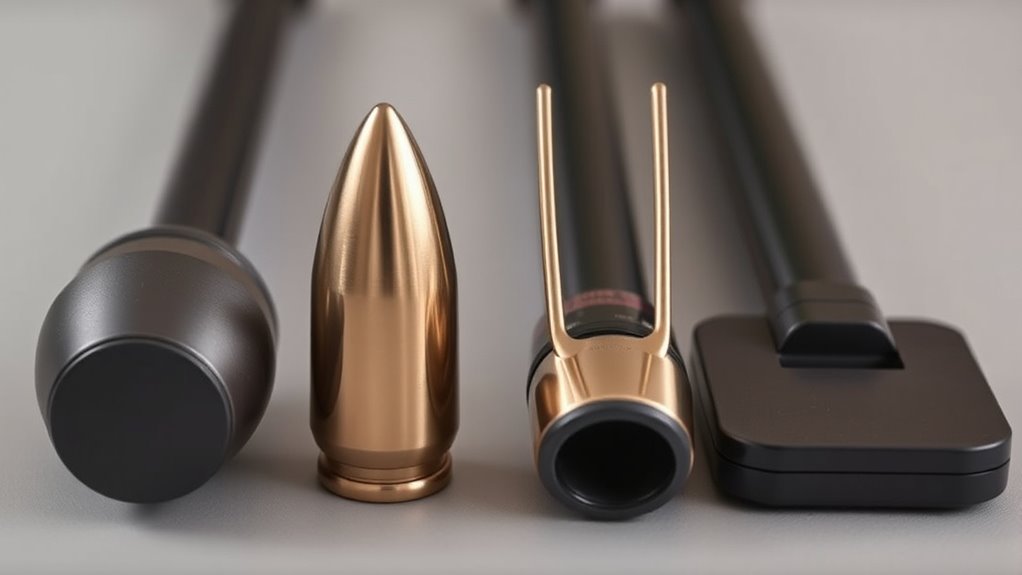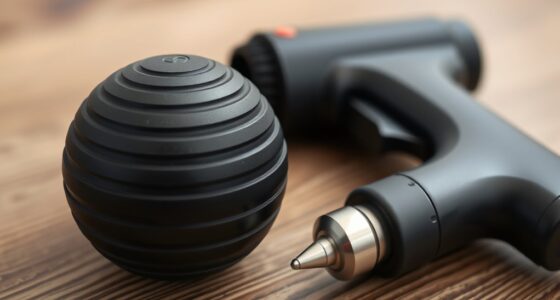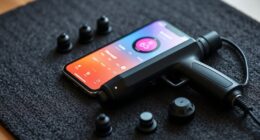Percussion massage attachments like dampener, bullet, fork, and flat help you target muscles more effectively. The dampener is soft and broad, ideal for gentle pressure on larger areas. The bullet is small and pointed for deep trigger points. The fork features split prongs for areas around the spine and neck, while the flat offers a wide surface for big muscle groups. Keep exploring to discover how each can boost your recovery and overall muscle health.
Key Takeaways
- Percussion massage attachments are designed to target specific muscle areas and tissue types for optimal recovery and relief.
- The Dampener attachment offers a soft, broad surface ideal for gentle, general muscle relaxation.
- The Bullet attachment is small and pointed, perfect for deep tissue work and releasing trigger points.
- The Fork attachment features a split design, suitable for delicate areas like the spine and neck.
- The Flat attachment provides a wide surface for large muscle groups, enhancing blood flow and muscle recovery.

Percussion massage attachments are vital tools that enhance the effectiveness of handheld massage devices, offering targeted relief for sore muscles and tension. When you’re seeking ideal muscle recovery, choosing the right attachment can make a significant difference. Each attachment is designed to work with specific areas and types of muscle tissue, so understanding their unique features helps guarantee attachment compatibility and maximum benefit. For example, the dampener attachment is typically larger and softer, making it ideal for broad muscle groups and gentle pressure, which helps in promoting blood flow and reducing muscle soreness. It’s perfect for general muscle recovery, especially after intense workouts or long periods of strain.
Percussion massage attachments optimize muscle recovery with targeted, compatible tools for specific areas and tissue types.
The bullet attachment, on the other hand, is smaller and more pointed, allowing you to target precise trigger points or knots. Its design makes it especially effective for deep tissue massage, helping release muscle tension at specific spots that may be causing pain or discomfort. When selecting attachments, considering the compatibility with your device ensures optimal performance and safety. When you use the bullet, you can focus on tight areas and achieve quick relief, making it a versatile tool for muscle recovery. Since not all devices are compatible with every attachment, you should check for attachment compatibility beforehand, guaranteeing it fits securely and functions smoothly.
The fork attachment offers a unique advantage when targeting areas around the spine or between the ribs. Its split design allows you to massage along the sides of the spine without applying pressure directly on the bones, making it an excellent choice for relieving tension in those delicate areas. It’s also useful for working on muscles like the trapezius or neck muscles, where precision and gentle pressure can improve mobility and reduce stiffness. Proper attachment compatibility is essential here because using an attachment that doesn’t fit properly can reduce effectiveness or cause discomfort.
Finally, the flat attachment provides a broad surface area, making it suitable for larger muscle groups such as the thighs, calves, or back. It delivers a more complete massage, helping to loosen tight muscles and accelerate blood flow for quicker muscle recovery. Its versatility makes it a staple in many recovery routines, but always confirm attachment compatibility with your device before use. By selecting the right percussion massage attachment tailored to your needs, you’ll maximize your muscle recovery process and enjoy more effective relief from soreness and tension. Remember, the key lies in understanding how each attachment interacts with your body and guaranteeing it’s compatible with your device for a safe and effective massage experience.
Frequently Asked Questions
Can These Attachments Be Used on All Body Types Safely?
Yes, these attachments can be used on most body types safely, but you should consider body compatibility and attachment safety. Always start with a lower intensity and monitor your body’s response. Choose the right attachment for your needs, such as the dampener for sensitive areas or the bullet for targeted relief. If you experience discomfort, stop immediately and consult a professional to guarantee safe use tailored to your body.
How Often Should I Replace Percussion Massage Attachments?
You should replace your percussion massage attachments based on their attachment durability and replacement frequency recommendations, usually every 3 to 6 months with regular use. Keep an eye out for signs of wear, cracks, or damage, and replace immediately if you notice any issues. Proper maintenance extends their lifespan, but timely replacements guarantee safe, effective massage sessions. Always follow the manufacturer’s guidelines for maximum performance.
Are There Specific Attachments Recommended for Athletes?
Yes, for sports therapy, you should use attachments like the bullet and fork, which offer attachment versatility for targeting specific muscles and trigger points. These attachments help you effectively reduce soreness, improve mobility, and enhance recovery. By choosing the right attachment, you can customize your massage to meet your needs, making your therapy sessions more efficient and beneficial for athletic performance.
Can I Use Attachments for Injury Recovery or Post-Surgery?
You can use percussion massage attachments for injury healing and post-surgery recovery, but it’s vital to consult with your healthcare provider first. Attachments like the dampener or bullet can target sore muscles and improve circulation, aiding recovery. However, avoid aggressive use or applying pressure directly on surgical sites. Always follow professional advice to guarantee safe, effective recovery and prevent setbacks during your injury management process.
Do Different Attachments Produce Different Noise Levels?
Think of your massage attachments as musical instruments, each with its own tone. The noise level variations depend on the attachment’s design and how it interacts with your device, so some may hum softly like a whisper, while others produce a louder beat. Durability also plays a role—sturdier attachments tend to maintain noise consistency over time. Choosing the right one ensures you enjoy effective relief without the raucous, like a well-tuned symphony.
Conclusion
Now that you’ve explored the different percussion massage attachments, it’s clear how each serves a unique purpose—like pieces of a puzzle fitting together perfectly. It’s almost like they were designed to complement your needs, whether for deep tissue relief or targeted therapy. So, next time you reach for your device, remember how these attachments can work in harmony, turning a simple massage into a personalized, effective experience—proof that sometimes, the right tools find you just when you need them most.









